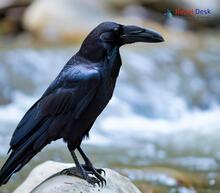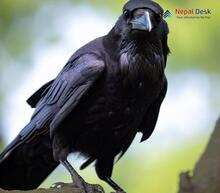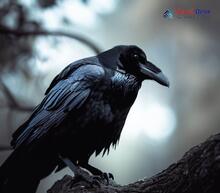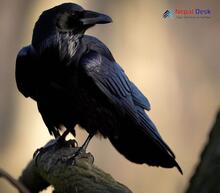The Corvus genus belongs to the family Corvidae and comprises over 40 species of birds commonly known as crows, ravens, and rooks, distributed widely across the world. Corvus displays distinct unifying morphological and behavioral characteristics that differentiate them from other bird genera.
Physical traits allowing for their adaptability and success include strong black bills used for foraging and feeding, black or black-gray predominant plumage providing camouflage, stout and agile bodies with hardy feet adapted to both arboreal and terrestrial habitats. They range considerably in sizes - from smaller, sociable house crows to large predatory common ravens spanning up to 4-6 ft wing spans.
Behaviorally, Corvus species are highly intelligent compared to other avian genera, displaying complex social organization, communication through calls, and problem-solving abilities like tool usage. Long-term social monogamy forms the basis of their populations' structure and information networking. Nests are intricately built to meet localized needs. Foraging is done both individually and collectively.
Combined anatomical and behavioral specializations contribute to the ubiquity and flourishing of Corvus genera from tropical to subarctic regions. They play integral roles as scavengers while adapting readily to man-made environments in many parts of the world. Several species hold cultural symbolism in mythology and folklore. In summary, Corvus denotes a successful, thriving lineage within global avifauna.
Diversity
The Corvus genus has achieved immense global success spanning an array of environments across all continents except Antarctica. Taxonomically, the group is further divided into several subgenera based on evolutionary lineages, with dozens of recognized species and innumerable sub-species adapted to specific locales.
In terms of anatomy, most crows and ravens within Corvus display predominant black or gray-black Iridescent plumage and feathering. Their thick, curved, or wedge-shaped bills are also black, suited for generalist omnivorous diets. North American ravens and Australian crows however have more specialized bills for meat-tearing. Similarly, body size can range from the relatively tiny Jungle Crow (~12 inches) to the imposing common raven (~2 ft). Most feature stout, perching body types with strong feet and legs to match their strident flight capabilities.
Behaviorally as well, certain traits prevail across the Corvus family. Highly social structures involving small family units that forage and roost communally at dusk are the norm. These wild birds utilize a wide repertoire of loud, guttural calls like cacophonous caws or eerie croaking for communication. Reports also indicate remarkably high learning, object manipulation, and puzzle-solving skills compared even to great apes - hinting at species-wide perceptive intelligence. Sexual offspring require extended parental care too.
In essence, adaptive calling cards in terms of external morphology and internal cognitive wiring underscore the success of these complex Corvid creatures, whether the mighty raven or the more humble crow next door!
Corvus Species Found in Nepal
The most ubiquitous is the Slender-billed Crow (Corvus enca), a mid-sized crow with dark black plumage and a distinctive narrowed bill. These extremely social, noisy birds forage in large flocks across villages and cities of the Nepali flatlands and foothills.
The larger House Crow (Corvus splendens) also abounds, identified via gray nape feathers. Often considered nuisance birds, these agile, opportunistic scavengers thrive around human settlements more than any other Corvus in Nepal.
In the higher Himalayan hillside forests, the Eurasian Jay (Corvus monedula) brings a splash of pinkish plumage and crest feathers with echoing shrieks. They roam alpine woodlands up to 12,000 ft in elevation.
The Yellow-billed Chough (Corvus alpinus) inhabits even more extreme high-altitude niches in the towering mountains, equipped with a specialized curved bill for digging and adaptation to rarified oxygen availability.
Although fewer in number, carrion-feasting ravens like the Large-billed Crow (Corvus macrorhynchos) and brown-necked raven (Corvus ruficollis) do occupy remote Himalayan regions as well.
The breadth of Corvus manifested in Nepal thus mirrors the country's diverse topography from steamy grasslands to icy massifs!
Habitats and Distribution
The ubiquitous Slender-billed crow thrives in both rural villages and bustling urban metropoles like Kathmandu and Pokhara in the central and western Nepali flatlands.
Riverside tropical forests, open grasslands, and scrub provide ideal scavenging grounds for opportunistic house crows found rampant across most of Nepal’s southern plains called the Terai region.
Encroaching the central Hill districts, house crows may intermingle near settlements with the highland-preferring Eurasian jay within cool broadleaf and coniferous forests dotted with rhododendrons.
Further west, the heights of the Dhaulagiri Himalayan range play host to the sure-footed and adapted yellow-billed chough which aerially patrols open slopes, moraine valleys, and rocky outcrops above 12,000 ft elevations.
Similar niche regions may support the occasional carrion-feeding common raven and the hefty horned lark-crow hybrid in western frontier districts abutting Tibet/China.
Essentially, Nepal’s dramatic landscape matrix encompassing subtropical lowlands, temperate mid-hills, and hostile high Himalayas provides viable breeding grounds for these remarkably adaptable Corvus cousins to claim ecological niches amid ever-encroaching human activity.
Behavioral Ecology
Nepali crows display complex social dynamics within large, loud communal roosts often located in dense trees or building crevices. Flocks may forage independently during the daytime but share information about good feeding sites via learned vocalizations upon returning. Bond pairings also cooperate in nest-building and territorial defense.
For sustenance, house crows epitomize invasive urban survivalists in Nepal by scavenging relentlessly on human waste and refuse. More forest-dwelling Eurasian jays employ a greater hunting-gathering approach, though still omnivorous in consuming plants, invertebrates, eggs, and small vertebrates opportunistically.
Dome-shaped nest constructions of interwoven twigs and mud clumped together provide protective reproductive sites, often dotted with white or blue-green eggs. Both sexes incubate eggs for 17-20 days until naked, helpless nestlings emerge who are then devotedly fed by parents for up to 5 weeks, followed by juvenile dependence too.
Lifespans in the wild range from 4 years for the smaller house crow to over 15 years for thicker-billed ravens. Persistence through harsh Himalayan winters and human pressures further attests to remarkable resilience.
The Corvid clan of Nepal has pioneered thriving in both untouched wilderness as well as crowded concrete jungles via behavioral plasticity - a true mark of biotic genius!
Ecological Role
By scattering seeds and plant material from fruits and grains during foraging activities, crows essentially support botanical regeneration within forest floors and grasslands. Carrion scavenging by ravens also cleans the landscape.
Complex interrelationships link the Corvus clan with other fauna as well – from nest parasitism by the Asian koels to jungle crows robbing eggs and chicks when possible. Gangs may mob much larger birds of prey like mountain hawk-eagles by bombarding them collectively till they leave the contested terrain.
At the same time, a bevy of external and internal parasites target crows and ravens uniquely as carriers or disease vectors – from malicious cuckoo fleas to tapeworms infesting organs. Only the hardiest Corvus persists in tolerating such exploitation.
Nepal’s human denizens share a turbulent equation with these sooty black-winged scavengers too – alternately appreciating nearly sacred large ravens and cursing crop-raiding urban crows. But the ubiquitous presence through bustling markets or remote river glen proves Corvus is firmly cemented in both ecological and cultural realms.
Come drought or blizzard, these intelligently indomitable Corvus cousins remain integral cogs that keep mountainous ecosystems as well as human complexity running!
Conservation and Environmental Impact
Legally, no indigenous Nepali Corvus faces overt endangered categorization currently, though several Himalayan species like the Yellow-billed Chough have poorly documented statuses.
Expanding human densification across foothills does endanger native forest-dependent species, however, like the ornamented Eurasian Jay. Mechanized farming also worsens habitat degradation and diminishes nest sites.
Counter-intuitively, human areas attract invasive opportunists like the house crow which has a detrimental impact on the scant native biodiversity left in protected zones. Their aggressive outcompeting of local avifauna is a worsening concern.
Mitigating measures focus on restoring undisturbed buffer woodlands via community management and regulating waste disposal near key settlements. Even religiously placed crow feeders at temples aimed at generating goodwill need strategic site selection to not artificially boost populations.
Public environmental education also offers promise for emphasizing ecosystem balance over species-centric feeding or forced control measures against these remarkably intelligent, sentient birds who may live alongside suburban communities in coming decades.
Cultural Significance
The jungle crow, locally called “kaag”, appears extensively in Hindu scriptures and legends where they act as messengers or harbingers associated with death. Their incessant cries near villages are viewed as ill omens.
In Buddhist tales, the alpine chough is venerated as the sanctified rebirth of divine scholars well-versed in dharma and worthy of offerings from the faithful. Sighting the auspicious “va-wa” is considered lucky.
Among indigenous Newar communities, clan totems uphold the nagi form, a mythical half-man-half-corvid ancestor. Various rituals and dances meant to pay homage to "Kul Devatas" may feature giant corvid effigies signifying knowledge holders.
Practices like ceremonial feeding of cooked rice to crows during death rites also remain actively practiced so the soul of the departed may follow such spirit guides to the afterlife.
The mystic aura surrounding the Corvus kind as either heralds of doom or wisdom persist within the unique Nepali cultural matrix where the line between ecological reality and mythological archetype is often blurred!
Research and Observation
Past observational studies have focused mainly on population monitoring of again invasive house crows in major municipalities, yet quantitative data remains lacking about most forest-dwelling Corvus species.
Vital long-term mapping of geographic ranges, feeding ecologies, and responses to climate change across Nepal’s landscapes is needed to fill knowledge gaps and predict sustainability amidst the Anthropocene era.
Towards this, the advent of digital databases like eBird where birdwatching enthusiasts can upload photographic records and chance sightings provides immense scope for citizen science initiatives. Retired birding expert Dr. Hem Sagar Baral has himself contributed decades of field wisdom on Himalayan birds through books. Many native Nepalis prospect keen ethno-ornithological observations too if engaged qualitatively.
Whether peering through binoculars at a city rooftop or trekking off-trail into remote rhododendron slopes, observers armed with recording tools and ethnic insights can unlock mysteries surrounding Nepal’s dynamic Corvus cultures – where science meets indigenous wisdom!
Guidelines for Wildlife Enthusiasts
Be respectful of local beliefs - certain communities may associate certain bird species with deities or spirits. Avoid superstitious persecution but take time to understand cultural perspectives.
When photographing magnificent birds like the Himalayan raven, limit using camera flashes or loud noises that may startle them. Approach nesting sites especially with great caution.
Support local ecology by hiring knowledgeable guides well-versed in indigenous wisdom who can share traditional stories while interpreting behaviors through a balanced lens, beyond just tourist snapshots. Stay on marked trails to minimize habitat disruption.
Be an ethical consumer - whether purchasing forest products or corvid-related souvenirs, ensure items come from sustainable green enterprises that channel profits to support local communities. Say no to wildlife trafficking of rare corvid specimens.
Above all, appreciate that we are but visitors in the intriguing lives of our viral Corvus cousins sharing Nepali ecosystems. Let experiences further bond global understanding across cultures and species!
Conclusion
Across Nepal's spectacular landscape palette spanning steamy tropical grasslands, lush rhododendron-dotted midhill forests to stark Trans-Himalayan slopes, the enduring adaptability and intelligence of the remarkable Corvus genus come to life.
From the raucous yet industrious slender-billed crows recycling urban detritus to the sure-footed, almost mystical yellow-billed choughs echoing hauntingly against craggy massifs - enduring evolutionary traits equipping resident Corvus species to carve diverse Himalayan niches persist evident. Cementing communal bonds, foraging opportunistically, and even manipulating humans display their mastery.
Still, burgeoning anthropogenic pressure through climate flux, rampant densification, and biodiversity attrition pose existential challenges for multiple resident corvid cultures, while certain human-habituated species battle conflict. Holistic conservation philosophies blending community stewardship, grassroots monitoring through crowd-sourced data sets, and empathy-based environmental education offer hope.
There remains much to discover about Nepal's dynamic Corvus denizens - from elevational range shifts to medicinal properties of adaptogenic nests. By sustaining intricate ecological balance also imbued with rich ethnocultural identity as harbingers and wisdom bearers, the mystique surrounding Nepal's ancient corvid chronicles persists!




